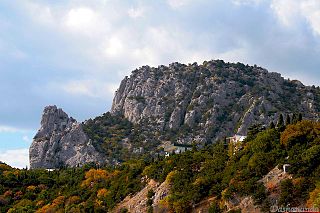This page is based on this
Wikipedia article Text is available under the
CC BY-SA 4.0 license; additional terms may apply.
Images, videos and audio are available under their respective licenses.
Grigory Nikolayevich Neujmin was a Georgian–Russian astronomer, native of Tbilisi in Georgia, and a discoverer of numerous minor planets as well as 6 periodic and a hyperbolic comet at the Pulkovo and Simeiz Observatories during the first half of the 20th century.
Sergey Ivanovich Belyavsky was a Soviet/Russian astronomer and a discoverer of 36 numbered minor planets.
Pelageya Fedorovna Shajn, née Sannikova, was a Russian astronomer in the Soviet Union and the first woman to discover a minor planet at the Simeiz Observatory in 1928. Pelageya also discovered numerous variable stars and co-discovered the periodic, Jupiter-family comet 61P/Shajn–Schaldach. She was married to prominent Soviet astronomer Grigory Shajn.
Vladimir Aleksandrovich Albitzky was a Soviet/Russian astronomer and discoverer of minor planets. In modern English transliteration, his surname would be given as Al'bitskii or Al'bitsky. In the literature, he is sometimes referred to as W. A. Albizkij, however his surname usually appears in the literature as "Albitzky". His asteroid discoveries are credited as "V. Albitskij".

The Pulkovo Astronomical Observatory, the principal astronomical observatory of the Russian Academy of Sciences, located 19 km south of Saint Petersburg on Pulkovo Heights 75 metres (246 ft) above sea level. It is part of the UNESCO World Heritage Site Historic Centre of Saint Petersburg and Related Groups of Monuments.
824 Anastasia is a main belt asteroid orbiting the Sun. It is approximately 34.14 km in diameter. It was discovered on March 25, 1916, by Grigory Neujmin at Simeiz Observatory in Russian Empire. It is named in memory of Anastasia Semenoff, an acquaintance of the discoverer.
The Crimean Astrophysical Observatory is located at Nauchnij research campus, near the Central Crimean city of Bakhchysarai, on the Crimean peninsula. CrAO is often called simply by its location and campus name, Crimea–Nauchnij, still ranks among the worldwide most prolific discovery sites for minor planets.

Count Dmitry Alekseyevich Milyutin was Minister of War (1861–81) and the last Field Marshal of Imperial Russia (1898). He was responsible for sweeping military reforms that changed the face of the Russian army in the 1860s and 1870s. Further, he was instrumental in creating the framework for the Circassian genocide that murdered approximately 600,000 Circassians from 1861 to 1865.

Mount Koshka is a mountain in the Crimean Mountains near the settlement of Simeiz within the Greater Yalta metropolitan area. The original name in the Crimean Tatar language means "double rock", while the Russian name means "cat", as the shape of the mountain resembles a lying cat. The height is 254 metres.
1059 Mussorgskia, provisional designation 1925 OA, is a background asteroid from the central regions of the asteroid belt, approximately 25 kilometers in diameter. It was discovered on 19 July 1925, by Soviet astronomer Vladimir Albitsky at the Simeiz Observatory on the Crimean peninsula. The asteroid was named for Russian composer Modest Mussorgsky. The X- or C-type asteroid has a rotation period of 5.636 hours.
1113 Katja, provisional designation 1928 QC, is a background asteroid from the outer regions of the asteroid belt, approximately 39 kilometers in diameter. It was discovered by Pelageya Shajn at the Simeiz Observatory in 1928, and named after Ekaterina Iosko, a staff member at the discovering observatory.
1121 Natascha, provisional designation 1928 RZ, is a background asteroid from the central regions of the asteroid belt, approximately 14 kilometers in diameter. It was discovered on 11 September 1928, by Soviet astronomer Pelageya Shajn at the Simeiz Observatory on the Crimean peninsula. The asteroid was named for Natasha Tichomirova daughter of astronomer Grigory Neujmin.
1129 Neujmina, provisional designation 1929 PH, is a stony Eoan asteroid from the outer regions of the asteroid belt, approximately 34 kilometers in diameter. It was discovered on 8 August 1929, by astronomer Praskoviya Parchomenko at the Simeiz Observatory on the Crimean peninsula. The asteroid was named after Soviet astronomer Grigory Neujmin.

1148 Rarahu, provisional designation 1929 NA and previously also known as 1148 Raraju, is an Eoan asteroid from the outer regions of the asteroid belt, approximately 32 kilometers in diameter. Discovered by Alexander Deutsch at the Simeiz Observatory in 1929, the asteroid's name was taken from a French novel by Pierre Loti.

Katsiveli is an urban-type settlement in the Yalta Municipality of the Autonomous Republic of Crimea, a territory recognized by a majority of countries as part of Ukraine and illegally annexed by Russia as the Republic of Crimea.
Aleksey Pavlovitch Hansky was a Russian astronomer.
61P/Shajn–Schaldach is a periodic comet in the Solar System with a current orbital period of 7.49 years.






